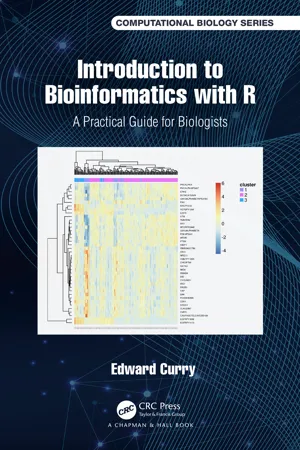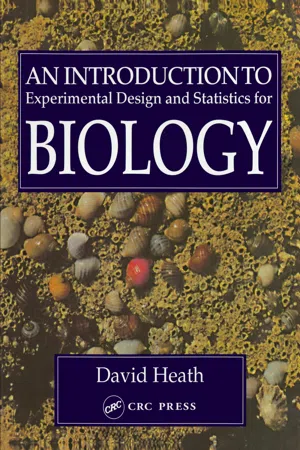Biological Sciences
Statistical Analysis in Biology
Statistical analysis in biology involves the application of statistical methods to biological data in order to draw meaningful conclusions. It encompasses techniques such as hypothesis testing, regression analysis, and experimental design to analyze and interpret biological phenomena. This approach is crucial for understanding complex biological processes, identifying patterns, and making informed decisions in biological research.
Written by Perlego with AI-assistance
Related key terms
4 Key excerpts on "Statistical Analysis in Biology"
- eBook - ePub
Introduction to Bioinformatics with R
A Practical Guide for Biologists
- Edward Curry(Author)
- 2020(Publication Date)
- Chapman and Hall/CRC(Publisher)
4 Statistical Methods for Data AnalysisIn this chapter we will try to get a good understanding of some analytical tools that will empower you to use datasets to answer real-world questions. You will see how some of the programming tricks can be used with R’s built-in number-handling functions to put the theory into a practical context.We start with an illustration of why we use statistical methods in research, to introduce the theory of probabilities, then describe some methods that use probabilities to help us attach confidence to observations in data.4.1What are statistical methods, and why do we use them in biological research?In applying statistical methods to data analysis, we are typically aiming to describe some properties of the data, or we wish to infer properties of what the data represent. I find the distinction between these aims quite revealing about why statistical methods are important in biological research. It should be intuitive that descriptive statistics are useful: these are the means of characterizing or summarizing properties of the data we have collected. But assuming we undertake research according to a traditional scientific method, we can advance knowledge through testing hypotheses: we use data to help us determine whether a hypothesis is supported by observation or should be rejected.Because it is rarely possible to obtain perfectly accurate measurements, nor to have complete control over all potential sources of variation in the systems being measured, we have to consider the fact that if we obtained more data, it probably wouldn’t be the same as the data we already have. The measurements we have are just representatives (this is a sample) of all such measurements that could have been obtained, if we had repeated the experiment infinitely (this is a population). We use statistical inference to estimate properties of that infinite set of all measurements that could have been obtained, by modelling these uncontrolled variations in the data as randomness - eBook - ePub
- Paola Lecca, Angela Re(Authors)
- 2019(Publication Date)
- CRC Press(Publisher)
Chapter 2 Statistical Physics in BiologyThe application domains of statistical physics in biology are multiple and led to the inclusion of statistical physics into the teaching programs of many courses at university level whose topics include bioinformatics methods for extracting information content from nucleotide sequences and structures and protein packaging as well as from a number of omics technologies-driven data types. If these fields are by now mature, the chapter “Statistical Physics in Biology” aims to expose the readers to statistical physics applications, which afford to understand biological entities at the systemic level, analysing them not only as individual components, but also as interacting systems and their emergent properties.The application domains of statistical physics in biology are multiple. The successful application of statistical physics ideas in biology led to the insertion of statistical physics into the teaching programs of many courses at the university level. They include bioinformatic methods for extracting information content of DNA; DNA sequence comparison, and phylogenetic trees; physical interactions responsible for structure of biopolymers; DNA double helix, secondary structure of RNA, and protein folding. All these fields now named are the oldest and most traditional application domains of statistical physics in biology, for which there is much good literature. So in this chapter, we are instead interested in exposing the most recent application domains, which concern the biology of networks. Indeed, statistical physics concepts are applied also in modelling the complexity of collective behaviour of biological elements, cellular networks, neural networks, and evolution. - David Heath(Author)
- 1995(Publication Date)
- CRC Press(Publisher)
1 Why Biologists Need Sampling, Experimental Design and StatisticsOur knowledge of the living world depends upon careful observation and experimentation, followed by analysis and interpretation of the results. Three indispensable tools used in this process are sampling, experimental design and statistical analysis. This chapter examines why they are so important and looks at some of the basic principles.What Biologists DoBiology is the study of the living world, a subject which ranges from the molecules that make up cells to the structure and function of whole ecosystems. When the subject was young a biologist such as Darwin could successfully investigate topics as diverse as earthworms, barnacles, orchids and evolution, but as our knowledge has expanded it has become impossible for any individual biologist to deal with the whole of the subject.Biology has become subdivided into a variety of separate specialised areas or disciplines, with individual biologists restricting themselves to the study of some small part of the subject. There are a number of different ways in which we can describe this subdivision. One is to use the different levels of organization of biological systems, starting at the level of molecules and progressing through cells, organisms and populations, to ecosystems. Such a subdivision is reflected in a range of different sorts of biologists, for example molecular biologists and population biologists. Another way of subdividing the subject is based on whether the organism being investigated is an animal, a plant or a micro-organism. There are biologists who would describe themselves as animal population biologists or plant molecular biologists, with even finer subdivisions and labels based on whether, for example, the animals of interest are vertebrate or invertebrate, insect or mollusc. Alternatively, we could use a scheme based on biological processes such as genetics, development or physiology. This too would produce a corresponding subdivision of biologists into types.- No longer available |Learn more
Basic Bioscience Laboratory Techniques
A Pocket Guide
- Philip L.R. Bonner, Alan J. Hargreaves(Authors)
- 2011(Publication Date)
- Wiley(Publisher)
Effective assessment of data requires statistical analysis, which could take various forms including basic descriptive statistics of data (e.g. estimation of midpoint and spread of data), to assessment of the relationships between different variables or sets of data. However, for effective communication of your findings, it is also important to present your data clearly and unambiguously in your laboratory report.Properly used, statistical analysis provides valuable support for the scientific validity of findings. However, improperly applied statistical analysis can be misleading as indicated by the numerous quotes you will see at discrete points in this chapter.Statistics “There are three kinds of lies: lies, damn lies and statistics” - Attributed to Benjamin Disraeli by Mark Twain. “Facts are stubborn but statistics are more pliable” - Mark Twain. “Definition of statistics: The science of producing unreliable facts from reliable figures” – Evan Esar.4.2 Statistical Analysis of Data: Some Key Definitions 4.2.1 Populations and Samples- These quotes refer to the common skepticism at the use of statistics to justify political decisions or to criticize those of opponents.
- This reflects the selective use of statistics to support a specific argument rather than the appropriate use of statistics to analyze the validity of data.
- The moral of the story is that an appropriate statistical analysis should be applied to the data in question and the method used should be declared openly and honestly in any publication or presentation using such data so that it can be open to scrutiny.
- In most areas of science there is not always agreement on the methods used to analyze data.
In statistics, the term “population” refers to very large sets of data that we would ideally want to analyze (i.e. large numbers of measurements). However, in reality it is simply not practical to analyze large populations. Instead, a sample
Index pages curate the most relevant extracts from our library of academic textbooks. They’ve been created using an in-house natural language model (NLM), each adding context and meaning to key research topics.



